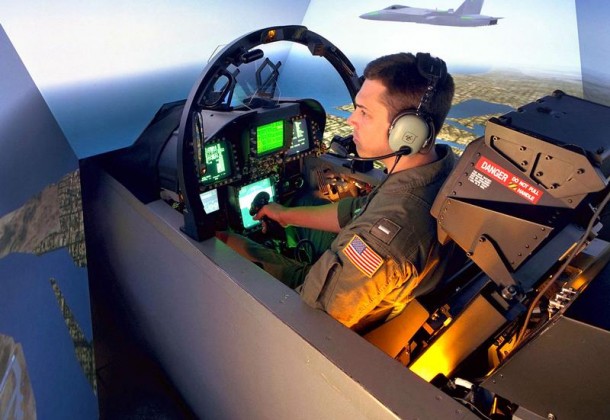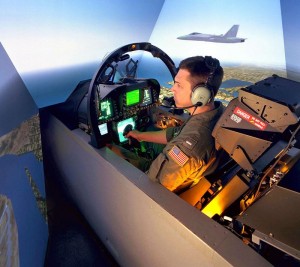AIR 4.6 Opens House, Ready to Make Deals

By Jay Friess
Editor

AIR 4.6 did not allow cameras into its open house Wednesday, but this image represents one of the simulators the office has created. (Image courtesy of the U.S. Navy)
The Research and Technology Office (AIR 4.6) of the Naval Air Systems Command is not the first place you would expect to see an open house event, and it’s certainly not a place you expect to hear a sales pitch.
But AIR 4.6 was buzzing with entrepreneurial energy Wednsday as representatives from the Navy’s weapon and aircraft programs visited to see what the office’s scientists and engineers have been doing at Naval Air Station Patuxent River office.
AIR 4.6 is a “competency,” an office of the U.S. Navy which gets its funding largely by loaning its engineers and scientists to Navy weapons and vehicle programs and by solving their problems. According to Joe Notaro, AIR 4.6 has a renewed interest in solving those problems inexpensively.
“We’re not breaking the bank anymore,” Notaro said. “We’re saving the taxpayers a lot of money.”
This is a common message from the Navy’s leadership these days, as Congress dithers over whether to head off hundreds of billions more in defense cuts, which are set to automatically kick in next year. From Adm. Jonathan Greenert, Chief on Naval Operations, on down to Rear Adm. Randy Mahr, head of the Naval Air Warfare Center Aircraft Division, the public message has been – we don’t need it perfect; we need it cheap.
That does not mean that it has to be a shoddy job. Notaro’s first stop on the AIR 4.6 tour was the modeling and simulation laboratories, where a Joint Strike Fighter simulator sat running a virtual Mach 1 flyover tour of St. Mary’s County on a 180-degree curved screen. Instead of an ultra-specialized simulator, however, the system was a representational cockpit with a few USB joysticks, a pair of flat touch-screen monitors and projectors drawing from a three-year old, off-the-shelf gaming machine running the free Linux operating system. The simulator, along with its helicopter cousin nearby, could be configured to reasonably resemble just about any jet or helicopter in the Navy.
The theme of using off-the-shelf technology to create custom solutions continued into the unmanned control laboratory, where engineers are working to design a common control system for Navy unmanned vehicles using open-source software and off-the-shelf hardware.
“We try to stay away from real software and real hardware until it’s necessary,” said Daniel Eksuzian, manager of human systems engineering at ARINC, a contractor working for AIR 4.6.
Eksuzian explained that his Navy program customers are looking for quick turnaround times and good cost for their engineering solutions. He said his team is currently working to create one common workstation that can control multiple drones in concert while keeping the human operator in control.
“We’re moving more from command and control of one platform to supporting a [military] objective,” Eksuzian said, adding that it’s important to keep operators involved at all times, not just when something goes wrong. “The human has to be in the loop at all times. It gets pretty hairy pretty fast when you talk about robot wars.”
Notaro said the common drone control station is one example of how AIR 4.6 is helping to anticipate the Navy’s future needs. He said, “We know where the Navy is going, and we want to support them.”























